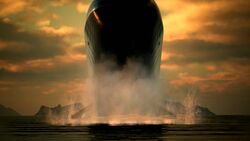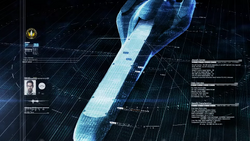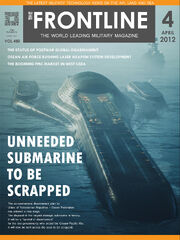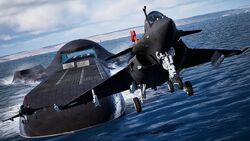- "Heed my words! This boat has the means to end this hideous war, in a definitive and elegant manner."
- ― Captain Matias Torres[1]
The Alicorn was a large nuclear submarine and the only known member of the Alicorn class of submersible aviation cruisers. It and its captain, Matias Torres are the main antagonists in the additional DLC story missions for Ace Combat 7: Skies Unknown.[2]
The Alicorn carried numerous weapons designed for mass destruction, including railguns that can fire shells equipped with nuclear warheads.[2] As the successor to the Scinfaxi class of submarines, the Alicorn also featured a runway and landing strip to support squadrons of fighter aircraft.[3]
The Alicorn was captained by Matias Torres, a radical member of the Erusean Navy. Torres wished to use the Alicorn to kill millions of civilians in Oured in order to horrify both sides into ending the Lighthouse War, which he believed would take ten million lives.[2]
It was destroyed during Osea's Operation Fisherman, being torn apart from the inside after Captain Torres's failed attempt to fire on Oured.
Etymology

The Alicorn breaching
"Alicorn" can refer to one of two things:
- the horn of a unicorn, from the Latin translation;[4] the design of the Alicorn—particularly the placement and size of the runway—resembles one of these single-horned creatures. This is especially evident when the Alicorn breaches the water's surface.
- a winged unicorn (a Pegasus with the horn of a unicorn); poet W. B. Yeats depicted winged unicorns as "creatures of ecstatic destruction" in the theatrical play The Unicorn from the Stars.[5] This aligns with the Alicorn carrying armaments equipped with nuclear warheads. Its central rail cannon can also be interpreted as the horn of said unicorn.[3][2]
Design
Vessel

The design schematics of the Alicorn

The propulsion specifications of the Alicorn
- "The sub's force projection capabilities are equivalent to a carrier strike group."
- ― David North[2]
The Alicorn featured a larger and more ambitious design than the Scinfaxi and Hrimfaxi before it. The Alicorn was 495 m (1,624 ft) in length with a long airstrip running down the middle of the submarine,[2] whereas the Scinfaxi was reported to exceed 300 m (980 ft) in length[6] and had a small vertical takeoff platform at the rear of the vessel.[7]
The Alicorn was a trimaran design - amidships, the vessel divides into three stern sections: the central airstrip and two large auxiliary hulls used for propulsion that contain its powerful arsenal. Underneath the airstrip, the Alicorn carries two nuclear reactors that power the entire vessel.[2] The Alicorn also features the ability to generate oxygen underwater, allowing crew members to survive when the sub is submerged even in the case of an accident.[3]
The Alicorn's specifications are as follows:[2]
- Length (submerged): 495 m (1,624 ft)
- Beam (submerged): 116 m (381 ft)
- Height (submerged): 54 m (177 ft)
- Displacement
- Submerged: 810,000 tonnes (800,000 long tons; 890,000 short tons)
- Surfaced: 650,000 tonnes (640,000 long tons; 720,000 short tons)
- Propulsion: Two nuclear geared turbines/turbo-electric mixed flow pump jets with conductive internal flow magnetohydrodynamics units
- Power: 300,000 horsepower (220,000 kilowatts) per jet
- Engine: Two liquid metal-cooled nuclear reactors
- Propellers: Seven forward-skewed propellers (estimated)
- Speed
- Submerged: 42 knots (78 km/h; 48 mph)
- Surfaced: 37 knots (69 km/h; 43 mph)
- Crew: 270–350
- Company: 150
- Air wing: 120–200 (20–30 aircraft)
- Force projection capability: 400 kilometres (250 mi)
Weaponry

The Alicorn's two railguns in the deployed position
The Alicorn features powerful weapons on both auxiliary hulls.
48 Vertical Launch System missile launchers are placed within both hulls. These VLS launchers support various short-range[2] and long-range missiles, including SLBMs. The SLBMs can carry various warheads, including 200 kt nuclear warheads.[3] Additionally, the Alicorn carries heavy anti-air armaments along its bow and stern, including CIWS and RAM missile launchers that are deployed from hatches within the hull. [8]
The Alicorn also carries two large electromagnetic railguns, one on each auxiliary hull, placed in front of the VLS launchers. Each railgun can fire 80 rounds per minute. The sabot in each railgun is 200 mm with a barrel length of 6.5 mm (33 caliber) and the capacity to support 155 mm projectiles, guided by GPS/INS. The projectiles range from Armor-Piercing Composite Rigid (APCR) shells to High-Explosive Anti-Ship (HEAS) shells

The rail cannon aboard the Alicorn
In addition to the two side railguns, the Alicorn is also fitted with a far more powerful 600mm/128 caliber rail cannon hidden underneath the carrier deck used for long-range attacks. Its estimated energy output is at least 500 megajoules. When it fires at minimum-energy trajectory, its effective range is over 3,000 kilometres (1,900 mi), possibly up to 5,000 kilometres (3,100 mi). The cannon's projectiles can change their flight paths using terminal guidance provided by an SLUAV. However, should the SLUAV be destroyed, a fail-safe forces the projectiles to immediately self-destruct.[9] It can even load discarding sabots armed with tactical nuclear shells. These 1 kiloton-yield projectiles are capable of killing anyone within a 400 metres (1,300 ft) radius around the impact site instantaneously.[2]
Finally, the Alicorn features a small jamming unit atop the superstructure used to produce ECM.
Aircraft

The runway on the Alicorn with two elevators raised
The Alicorn has a large carrier deck for full carrier aircraft integration. Additionally, 8 large bays on each side of the superstructure house launch ports for SLUAVs[10] and Barrier drones, which can be used even underwater.[11] The Alicorn can carry at least 20 and at most 30 manned aircraft, depending on the type of aircraft and the number of crew required to maintain them. The Alicorn supports five distinct aircraft configurations:[2]
- 20 Su-33 Flanker-Ds
- 22 F/A-18F Super Hornets
- 24 MiG-29Ks
- 30 Rafale Ms
- An unknown number of SLUAVs
- An unknown number of barrier drones
History
Development
Yuktobania initiated "Project Alicorn" in 1998 to create a "Super Scinfaxi-class" submarine that combined the capabilities of the Scinfaxi and Hrimfaxi. The Osean Intelligence Agency's (OIA) Advanced Weapons Analysis division observed sand carriers actively excavating underneath Okchabursk in 1999. The underground facility beneath the city already housed two 400-metre (1,300 ft) docks to repair and maintain the Scinfaxi and Hrimfaxi, but the sand carriers were still excavating an estimated 1,000 cubic metres of sand every day.[2]
The OIA suspected that, within a year, Yuktobania completed construction of a new 600-to-700-metre dock for the "Super Scinfaxi-class" submarine. The OIA observed the steel and weapons being delivered to Okchabursk to estimate the Alicorn's capabilities. The Advanced Weapons Analysis division completed its report on the new submarine on March 27, 2000.[2]
The Alicorn's actual construction period is unknown, nor is it confirmed if Yuktobania ever finished it. It did not take part in the 2010 Circum-Pacific War and at no point in the conflict did Osean forces approach Okchabursk to threaten it. By 2012, Yuktobania had completed most of the ship's hull.[2]

FRONTLINE's issue on the Alicorn
On April 4, 2012, FRONT LINE published an issue on the Alicorn, detailing the ship's history and potential future, stating that Leasath, Estovakia and Erusea were all likely candidates for purchasing the submarine. The author stated that despite Leasath's desire to develop its naval capabilities, Estovakia was most likely to purchase the ship due to its stagnating Aerial Fleet development and Osea's increased restriction of Belkan weapon sales.[10] On December 20, GAZE reported that the Kingdom of Erusea ultimately purchased the Alicorn and noted that the submarine was seen two days earlier being towed.[2] Erusea purchased the Alicorn as scrap metal from Yuktobania via a private company known as GR Trading,[1] then refurbished it into working condition.[3]
At one point, the Alicorn and its long-range armaments were reported as a potential violation of the START2 treaty.[3]
Launches and grounding
Erusea did not officially launch the Alicorn until January 1, 2015. Matias Torres was eventually assigned as the submarine's captain; on December 2, 2015, he was reassigned as the head of the submarine's pre-commissioning crew.[2]
The Alicorn sailed out for a sea trial on October 9, 2016. It accidentally ran aground underwater one month later on November 10.[2] GAZE reported that the submarine had gone missing in the Spring Sea, 1,300 km (810 mi) south-southeast from the Twinkle Islands. Erusea insisted that "no radioactive materials [were] released in the Spring Sea" and "maritime traffic safety [was not] compromised".[3] The submarine resurfaced two years after sailing, on October 9, 2018.[2] It had gone MIA due to being run aground while underwater and remained on the seafloor for 698 days. Several of the crew perished, though the vast majority survived.[1]
Lighthouse War
Following its discovery and the rescue of the crew, the Alicorn was transferred to the Erusean Navy's reserve fleet on November 3, 2018;[3] the same day, Torres was again reassigned as the head of the pre-commissioning crew.[2] Despite the outbreak of the Lighthouse War the following May, the Alicorn remained dormant in an unknown location since it was not part of Erusea's battle doctrine.[3] At most 30 of the Alicorn's crew members left the ship, but they continued to operate for the Alicorn by sabotaging both Osean and Erusean military forces. One of them, Edgar Saxon, provided Osea's Brigadier General Howard Clemens with false intelligence. Other agents stole railgun-compatible nuclear shells for the Alicorn.[9]
Erusea lost the Njord Fleet on August 10, 2019 during Osea's Operation Siren's Song.[12] The next day, Erusea formally commissioned the Alicorn into active duty to plug the deficit in its navy.[2]

The Alicorn firing anti-ship missiles at an incoming Osean Maritime Defense Force landing force

SACS launching from the runway aboard the Alicorn as it leaves Artiglio Port
On September 4, the Alicorn was docked in Artiglio Port, which was under Osean control at the time.[13] OIA analyst David North contacted the Long Range Strategic Strike Group (LRSSG) to explain the situation. Operating under Brigadier General Clemens' false intelligence, Osea launched Operation Sighthound and sent the LRSSG's Strider Squadron, other OADF aircraft, and a small detachment of OMDF ships to capture the Alicorn. The Erusean Air Force sent wave after wave of fighters, strike aircraft, and even EW aircraft to defend the sub, but the Oseans broke through their defenses. As the battle reached its climax, Erusea's high ranking officials ordered Captain Torres to scuttle the Alicorn immediately, but Torres refused the order, declaring the Alicorn to no longer be under the jurisdiction of the Erusean military. Leaving its dock, the Alicorn opened fire on the OMDF fleet with its railguns, sinking the landing ship Puffin and several other ships that had taken defensive positions with a single shot, and destroying the rest of the fleet with its missiles. SACS took off from the sub with a cruise missile in tow, attempting to flee the airspace as a decoy to allow the Alicorn to submerge. Trigger shot down all SACS aircraft, but by then, the Alicorn had already submerged and left the area.[1]
On September 10, the Alicorn attempted to shoot down Strider Squadron over Anchorhead Bay with its long-range rail cannon attacks from a few hundred kilometers north of Tyler Island during Strider's Operation Domino. The first attack managed to damage Húxiān's aircraft, forcing her to retreat. The attacks continued even when Trigger was engaging Mimic Squadron, but did not severely harm Trigger or any other units. Five hours later, as Strider Squadron has already left the airspace, the Alicorn entered the bay without having to face any resistance thanks to Strider eliminating most Erusean forces. The submarine met with its agents in Anchorhead to resupply and load the nuclear shells before leaving, all in less than 10 minutes. The OIA confirmed Edgar Saxon as Brigadier General Clemens' source of intelligence and arrested Clemens on charges of treason.[9]
By September 14th, the Alicorn arrived in the Spring Sea near the Azalea Seamount. The plan was to fire on Oured on September 19th, the 15 year anniversary of the end of the Usean Continental War. The sub began heading for the Peony Trench, an abyss where it could feasibly reach its max operating depth of 600m, far too deep for any attack to reach it. However, before it could reach the trench, Osea initiated Operation Fisherman to destroy the sub once and for all.[11]
The sub's air group engaged Strider Squadron and the Osean ASW aircraft but were unable to stop them from dropping sonobuoys around the area. A small Osean Navy task force of three destroyers and one cruiser located the Alicorn underwater with the help of the sonobuoys and a Magnetic Anomaly Detector (MAD) mounted on Trigger's aircraft, with each ship launching a VL-ASROC at the sub, forcing it to surface. Since the attack had impaired its ability to dive, the Alicorn was forced to engage Strider and Cyclops Squadrons. It had two tricks up its sleeves - ECM jammer and barrier drones. These drones emitted EM fields much like the Arsenal Bird's APS and prevented the Osean craft from getting a clear shot. Despite this, the Oseans continued to fight, critically damaging the Alicorn's ballast tanks, preventing it from diving.[11]
Realizing the severity of the situation, Torres faked a call to surrender, causing the Oseans to disengage. Despite the LRSSG's protests, AWACS Long Caster forbid the Osean craft from attacking due to attacking a surrendering ship being a breach of international law. David North attempted to reason with Torres, only for the Alicorn to deploy its rail cannon. Disobeying orders from Long Caster, Trigger wove through the barrier drones and fired on the cannon, the impact altering its trajectory ever so slightly and causing it to miss its mark.

The bisected Alicorn sinks beneath the waves
With the ruse up, Torres engaged all remaining defenses and prepared to fire his only remaining shell. With the Alicorn's fire control systems damaged, the barrel of the rail cannon could not be elevated manually, so Torres began to purposefully flood the aft trim tanks to elevate the barrel to the angle necessary to make the shot hit home on Oured. Before he could fire, however, Trigger destroyed the base of the rail cannon, causing a huge explosive chain reaction to rip through the submarine, killing Torres and the entire crew while splitting the submarine into two pieces amidships. The submarine's bisected halves sank beneath the waves before exploding violently, destroying the Alicorn once and for all.[11]
Spies
As the Alicorn began to rebel, 30 members of its crew left the submarine and began to work as agents for the Alicorn. They worked to sabotage both the Erusean and Osean militaries to further the Alicorn's plot. These 30 crew members are as follows:[9]
- Lieutenant Colonel Alexandra Randall
- Major Volfango Zaccarini
- Captain Jean-Paul Bellecourt
- First Lieutenant Nikolai Smirnov
- First Lieutenant Friedrich Rudel
- Second Lieutenant Roland Lindbergh
- Second Lieutenant Janssen Willems
- Second Lieutenant Falco Zaccarini
- Second Lieutenant Edgar Saxon
- Midshipman Harry Talbot
- Midshipman Hermut Schmidt
- Midshipman Heinrich Altmann
- Midshipman Matteo Ferrari
- Warrant Officer Lorenzo Bruno
- Warrant Officer Sean Higgins
- Warrant Officer Claude du Pont
- Warrant Officer Badavi Ismayilov
- Warrant Officer Jose Beltran
- Chief Petty Officer Mor Haddad
- Chief Petty Officer Nguyen Tan Vinh
- Petty Officer First Class Gustav Raiffeisen
- Petty Officer First Class Bradley Robinson
- Petty Officer Second Class Aziz Jalal
- Petty Officer Second Class Theodore Winchester
- Petty Officer Second Class Allan Ken Onizuka
- Petty Officer Third Class Georgy Borodin
- Petty Officer Third Class Carlos Vázquez
- Marine Rodrigo Marques
- Marine Mika Vatanen
- Marine Jan Olsen
Gallery
The Alicorn in a 2012 FRONT LINE issue
The Alicorn alongside the Erusean Royal Navy
SACS aircraft taking off
The Alicorn during Operation Sighthound
SACS Squadron on the Alicorn's runway
The Alicorn and Trigger depicted as chess pieces
The Alicorn during Operation Fisherman
Trivia
- The Alicorn is designated as a "Submersible Aviation Cruiser" in the briefing of Unexpected Visitor. Aviation cruisers are a class of aircraft carrier combining the offensive potential of a cruiser and the aircraft carrying potential of an aircraft carrier. In particular, Russian aircraft carriers are often referred to as aviation cruisers. Aside from being an aircraft carrier with extreme offensive potential, the Alicorn being designated as an aviation cruiser may be a reference to the fact that it is Yuktobanian in origin. Yuktobania is heavily based on the Soviet Union, and this may have influenced the sub's designation.
References
- ↑ 1.0 1.1 1.2 1.3 SP Mission 01: "Unexpected Visitor", Ace Combat 7: Skies Unknown.
- ↑ 2.00 2.01 2.02 2.03 2.04 2.05 2.06 2.07 2.08 2.09 2.10 2.11 2.12 2.13 2.14 2.15 2.16 2.17 2.18 2.19 File:Ace Combat 7 Skies Unknown - Season Pass Mission Trailer.
- ↑ 3.0 3.1 3.2 3.3 3.4 3.5 3.6 3.7 3.8 File:Ace Combat 7 Skies Unknown - DLC Mission Teaser.
- ↑ Shepard, Odell (1930). The Lore of the Unicorn. London: Unwin and Allen. ISBN 9781437508536.
- ↑ https://www.jstor.org/stable/2872885
- ↑ New Submarine.
- ↑ Mission 07: "Front Line", Ace Combat 5: The Unsung War.
- ↑ File:Ten_Million_Relief_Plan_Store_Image.jpg
- ↑ 9.0 9.1 9.2 9.3 SP Mission 02: "Anchorhead Raid", Ace Combat 7: Skies Unknown.
- ↑ 10.0 10.1 FRONT LINE: Unneeded Submarine To Be Scrapped
- ↑ 11.0 11.1 11.2 11.3 SP Mission 03: "Ten Million Relief Plan", Ace Combat 7: Skies Unknown.
- ↑ Mission 11: "Fleet Destruction", Ace Combat 7: Skies Unknown.
- ↑ Mission 13: "Bunker Buster", Ace Combat 7: Skies Unknown.
















